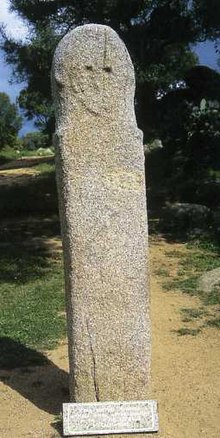Filitosa
Location Filitosas in Corsica |
Filitosa is a small village in the municipality of Sollacaro on the French Mediterranean island of Corsica . The village is located about 20 km north of the coastal town of Propriano in the Taravo Valley and is one of the key places in Corsican prehistory.
prehistory
There is evidence that the area has been inhabited for around 8,000 years. Traces were found from the Neolithic Age (from 6,000 BC), but especially from the megalithic culture (3,500 - 1,600 BC), and from the Torrean (1,600 - 800 BC). The finds are in a small museum issued at the facility.
Nowhere else in Corsica can you find the statue menhirs of the Megalith and the Torren of the Torrean people in the same place . From the fact that the statue menhirs are often smashed and used as building material in the buildings of the Torreans, the archaeologist Roger Grosjean concluded that the cultures were hostile to one another and that the Torreans gained the upper hand. However, 60 Corsican statue menhirs have been preserved - most of them in Filitosa, which lies in the middle of an old olive grove.
A cyclopean curtain wall surrounds the oval hill of Filitosa, which consists of east, central and west monuments. As in Corsica, the monuments are often combined with natural rock formations. The eastern monument at the entrance is a tumulus-like , stone-framed rotunda from the Torrean era. Its meaning is unclear. A 15 ton boulder resting on stone slabs was built into the wall of the monument.
Megalithic III and the middle and late Torrean epoch are combined in the central monument. A vertical polishing stone with a double hollow (megalithic II or III) is inserted into the wall. In the middle of the cella there is burnt clay soil (sacrificial site). 32 fragments of menhirs and menhir statues of Megalithic III, which were smashed by the Torreaner, were built into the wall of the central monument as building blocks. Among them are six tops of menhir statues.
Between Central and West Monument are two rock shelters or Tafoni . Abri 1 was used as a dwelling or burial place during the various settlements on the hill. Abri 2 is a dolmen-like cave that opens to the south.
The western monument is a structured system consisting of a central building and its southern extensions. The diameter is 16 to 18 m. The southern extensions consist of corridors (one covered with slabs), a rock cave, the well, as well as sheds and chambers. The main part of the plant consists of the two-part structure. The inner chamber was originally filled with stones and separated from the outer one by a transverse wall. Traces of a fireplace and a conical stone in the style of baityloi were found on the burnt floor . The chamber was probably walled up for ritual reasons. The floor of the outer chamber also showed strong traces of fire. It is probably around 1200 BC. Has been used for the last time. The remains of a single human skull came to light beneath the stone and earth rubble from the ceiling collapse. Next to the separation wall, under a lintel, there is access to an underground, carved cave, which forms a secondary chamber. The archaeological findings suggest that this complex, like the rest of the Torren, is a place of worship.
The descent into the valley of the Barcajolo river is past the western monument. Below are five menhir statues that have been found scattered in Filitosa and its surroundings. The statues are considered masterpieces of megalithic art. Among them is the statue menhir Filitosa V, the second largest is also considered the most beautiful.
Nearby are the Torre Castellu di Cuntorba and the Chalcolithic archaeological site I Calanchi.
literature
- Roger Grosjean : The Megalithic Culture of Corsica. In: Die Umschau in Wissenschaft und Technik 64, 1964, H. 13, ISSN 0041-6347 , pp. 403-407.
Individual evidence
- ^ Giuseppa Tanda: Gli Scavi nell'Abri 1 o Sapar'Alta, in località I Calanchi (Sollacaro, Corse du Sud). Campaign 1991-1996
Web links
Coordinates: 41 ° 45 ' N , 8 ° 52' E


